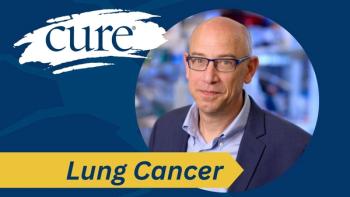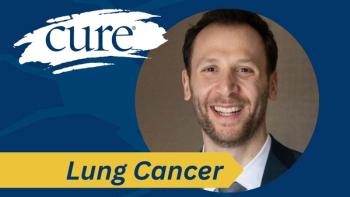
Presenting Treatment Options for Small Cell Lung Cancer
Transcript:
Philippa Cheetham, M.D.: So, for patients who are diagnosed with small cell [lung cancer], the plan is to talk about chemotherapy treatments, radiation treatments. Before we come to those, when you break the news to the patient that surgery is not the way to go for the overwhelming majority of patients, is that welcome news, to avoid an operation, or do some patients find that a difficult concept to swallow?
Edward Kim, M.D., FACP: I think when we talk about limited-stage small cell [lung cancer], we still classify that as a curative intent treatment. And so whether it is radiation and chemotherapy, or again the very exception of surgery, it’s still curative intent. So that keeps them grounded in that game plan. In non-small cell where we see more of that surgery versus chemotherapy and radiation, I think there is more of an effect there.
Philippa Cheetham, M.D.: There are always some patients, aren’t there, who are very keen to avoid an operation in any cancer and other patients who psychologically think if it’s cut out of my body somehow, the outcome is better.
Edward Kim, M.D., FACP: That’s right, or they can’t see it on a CT [computed tomography] scan anymore, it must be gone.
Philippa Cheetham, M.D.: Right. You talked already about chemotherapy and radiation therapy. Is it always both together or can it be either/or, and how do you determine the best treatment for small cell?
Edward Kim, M.D., FACP: The standard treatment, and the one that has been tried and true for the last couple of decades is to give radiation and chemotherapy together. And, frankly, and I don’t like to always admit this, but the radiation is really important here because that is the additional therapy that is trying to add to that curative potential. So do not wait on the radiation. I have seen some places where they start the chemotherapy because the radiation is going to take a month or longer to plan. You can’t wait that long. You’ve got to get the radiation going quickly. It’s not about the chemotherapy scheduling.
Philippa Cheetham, M.D.: In terms of the treatment protocol, we usually treat patients with radiation Monday to Friday, so it’s usually treatment during the weekdays. What typically would be the number of radiation treatments patients would get for a small cell tumor?
Edward Kim, M.D., FACP: So, for small cell, it generally is about a month of radiation treatments and just as you say, that five day on, two day off schedule that they never talk about, the Monday through Friday. The chemotherapy would occur pretty much every week....
Philippa Cheetham, M.D.: So you’re talking about 20 treatments roughly, radiation, would you say?
Edward Kim, M.D., FACP: Yes, they get about 40 gray or so in that area.
Philippa Cheetham, M.D.: Right, so 20 separate visits Monday to Friday, five days a week, four weeks of treatment.
Edward Kim, M.D., FACP: That’s right.
Philippa Cheetham, M.D.: And the chemotherapy. Explain a little bit more about what that involves.
Edward Kim, M.D., FACP: We give two drugs with it, and one of the drugs is given every three weeks and the other drug is given on days one, two and three every three weeks. So they’re divided up that way. A cycle entails an entire three-week period. And so even though you only get the drugs on the first few days, you then let the drugs have their effects. It takes about 21 days for that to happen, and then a patient would come back, continuing their radiation throughout this, and we would check their blood counts. As long as the blood counts looked good and the patient looked good, that’s more important than the blood counts, then we would give them the second cycle. And we generally keep going with the chemotherapy past the radiation for a total of four cycles.
Philippa Cheetham, M.D.: Not all chemotherapy is intravenous. Are you talking about pills? Are you talking about infusions?
Edward Kim, M.D., FACP: For this situation, actually one of the drugs can be given as pills, that is the etoposide, but we prefer to give it intravenously. So both of the drugs are given intravenously.
Philippa Cheetham, M.D.: This is obviously standard of care treatment that’s been around for a long time. You’ve already touched on possible delays getting radiation treatment planned. Do you ever have any problems based on patients’ insurance in terms of getting these drugs approved, so that patients can start treatment in a timely manner, or is that not an issue?
Edward Kim, M.D., FACP: Luckily, with these drugs we don’t have as much of an issue with patients’ insurance. I would love to say that insurance companies are very easy to work with and we are working in that direction, but it is still a struggle sometimes. But in this situation of limited stage small cell, the protocol is pretty standard and we don’t have too many hurdles there.
Philippa Cheetham, M.D.: Now, for so many cancers, when we talk about chemotherapy, that’s for cancer that’s already spread beyond the primary site. But here we’re talking about chemotherapy for patients who still have disease that’s confined to the chest, yes?
Edward Kim, M.D., FACP: Yes, it is an enhancement to the radiotherapy. So they work together and, additively, do better effects, or synergistically.
Philippa Cheetham, M.D.: And is that because the chemotherapy sensitizes the cancers to the radiation or is it because the chemotherapy may or may not be treating microscopic cancer cells that have gone elsewhere in the body that the scans may not necessarily detect?
Edward Kim, M.D., FACP: I do tell people that these scans are not cancer cell scans. It’s like if you looked at a telescope of the moon and you would have an idea of what the moon surface is, but it’s not what you think through a telescope. You’ve got to step on it to actually see what the surface is. We know there could be cells elsewhere, and we like to think that the chemotherapy does in fact eliminate that risk or at least reduces that risk. But, again, chemotherapy doesn’t work against cancers 100 percent, we know that. And so we’re hopeful that it catches or suppresses some of those, but it’s mostly an effect in combination with a radiotherapy to give that additive boost.
Transcript Edited for Clarity





